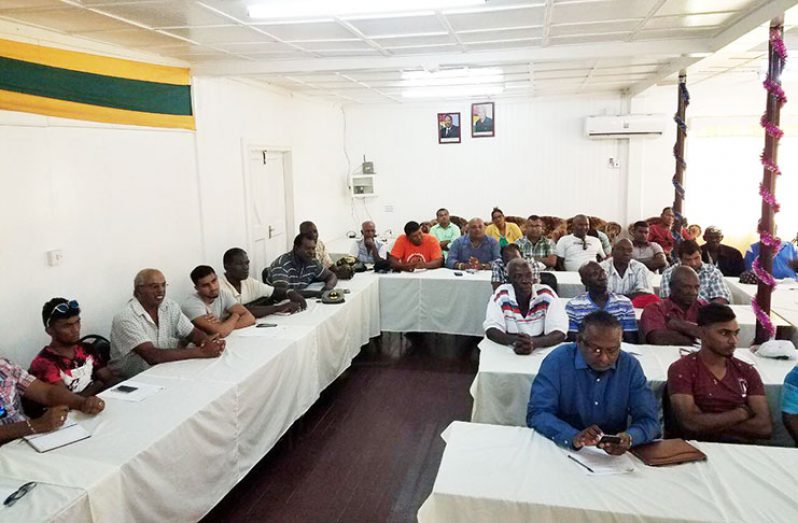–to meet demand for biofuel to run co-generation plant
SKELDON Energy Inc. (SEI) on Thursday told attendees at a multi-stakeholder meeting that it is in search of local suppliers of some 100,000 tons annually of biomass to generate enough biofuel to power its co-generation plant.
SEI said it’s targetting ‘the small man’ in its quest to make use of waste
from rice, coconut and lumber to be used to make biomass fuel, also known as biofuel, to power the plant year-round.
According to SEI, the plan is to get laid-off sugar estate workers and the average man to make use of products that would have otherwise been discarded and sell it to them, and in so doing earn some income from waste.
The company said it’s willing to pay a little above what it would have paid the Skeldon Estate for its bagasse, due to the economic value it knows generating biofuel from waste could bring to the community.
“We are willing to pay an average of four to five thousand dollars per
ton for paddy shell, rice straws, saw dust, coconut shells and lumber,” SEI’s Carvil Duncan said, adding:
“In the case of lumber, it translates to around $12,000 per cord, which
is not bad at all. And even though we may pay a bit higher than normal,
we are willing to do so because of the economic opportunities it
presents to the community.”
Duncan assured those present at the meeting that while prices are negotiable, based on the heat value of the raw material, contracts will be provided suppliers, thereby safeguarding their being able to recuperate whatever investment they would have made. On top of that, Duncan said the company is also willing to help negotiate tax and or duty-free concessions for whatever equipment they may need to do the business.
The meeting, which was held at the GuySuco Training Centre at the Skeldon Eastate, saw representatives of almost every sector of the agricultural community being afforded the opportunity to air their views.
MAJOR CONCERNS
Among major concerns that were raised came from President of the Central Corentyne Chamber of Commerce, Mohamed Raffik, who said that with lumber being amongst the list of products being considered for making biofuel, it may vary well lead to deforestation in direct contradiction to what SEI is hoping to achieve.
Raffik said that with 100,000 tons annually being equivalent to an average of 333 tons of lumber daily, that in his opinion, would lead to massive deforestation by unscrupulous persons simply trying to earn a quick dollar.
However, the management of SEI assured him and those present that they
have already spoken to the Guyana Forestry Commission about the likelihood of overharvesting, and that in any case, they are only going to be accepting the residue of non-commercial species of lumber. Again, lumber is just a short-term plan, SEI said.
Explaining how the process works in the case of lumber, Duncan said that after the tree is stripped, only a fraction of it is used for logging. The remainder of it, he said, is what they are seeking persons to collect and sell to them for fuel purposes. He also noted that with a combination of the various types of biomass, the daily target can be easily achieved.
He said the company’s long-term plan is to source 2000 hectares of land to plant fuel grass to supply its boilers.
Gobin Harbajan, who chaired the proceedings and was instrumental in
proposing the idea, reassured stakeholders that rather than give
the contracts to a single person or company, what SEI is proposing presents an opportunity for the entire community to be involved and earn much-needed revenue.
He also noted that presently, residents of the riverine community of Bara Cara has an arrangement with SEI, whereby they are supplying the company with lumber.
SEVERAL OPTIONS
Said he: “There are several options to consider, and the idea is to let the
average person get a piece of the action, which is why I got involved.
We spoke to residents of Orealla, and the owners of barges to look at
how we can work out something, where they bring out the waste from the
logging operations and get paid for it.
“Other options include getting trucks and going around to various communities and collect the shells and other items etc. There is a lot of potential for people to get employment and earn money from materials that they would normally have discarded. And that is the main idea behind this venture.”
SEI is presently selling power to Guyana Power and Light Inc (GPL) from its co-generation plant, and previously depended on bagasse from the Skeldon Estate to power its boilers.
But even with the estates in operation, they would have only been able to
get bagasse for three months, and with the closure of the estates, they have decided to look at alternative sources of year-round supply.
In so doing, they’ve decided that bio-mass fuel would be their best immediate option, given that Region Six (East Berbice-Corentyne)
is an agricultural Region, until it gets into grass fuel.
They are willing to negotiate and meet the suppliers halfway, given the socio-economic benefits the venture would provide citizens, and are inviting interested parties, preferably individuals, to make contact with
them.
The company has the capacity to store 3000 tons of biomass, and is
confident the venture can be profitable for all, even though some form
of pelletising, compression and rikiting may be required for paddy
shells, rice straws and sawdust.



.jpg)











